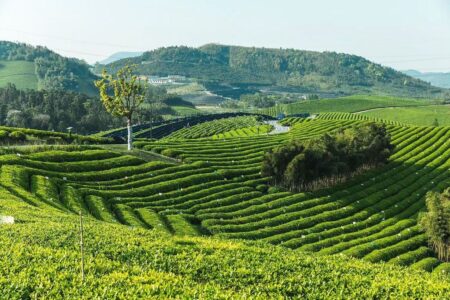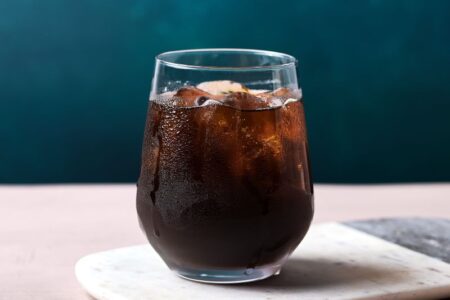Art of the Tea Latte

Image credit: Daniel Agee
The tea latte, a latte with a tea base rather than espresso, is an emerging tea category that can offer cafés and coffeehouses a creative menu option to appeal to specialty tea fans looking for new and different tea beverages.
By Maxwell C Pollock
The latte is a menu must-have in cafés worldwide. Latte, shortened from caffè latte, the Italian term for coffee with milk, is an espresso base topped with steamed milk. Despite its basic definition, the classic drink has birthed an entire ethos unto its own, spawning the likes of latte competitions where baristas test their abilities to craft great tasting lattes and display milk froth art talents. Branching off this coffee staple, the tea latte, a latte with a tea base, has emerged as a product expected from café audiences everywhere.
What is a Tea Latte?
A tea latte is a near-identical variation to the caffè latte that relies on a tea base instead of espresso. Although the roots of the tea latte are debatable, some argue consuming tea with hot milk was developed in 1800s India.
India’s newly developed tea industry exported to England while establishing the product as an everyday consumable in the subcontinent. As a result, spices native to India were infused with locally produced black tea and infused in boiling milk to create masala chai, “mixed-spiced tea” in Hindi.
Fast-forward to 1990s Seattle. Starbucks Coffee launched the chai latte, propelling a then-niche beverage concept to the mainstream. Since Starbucks’ subsequent expansion, café-goers have come to expect chai lattes as a basic menu item. Employing alternate tea variations to chai, such as Earl Grey for London Fog and matcha for green tea lattes, coffee and tea companies have unpacked a continually-developing tea latte category.
Trending Methods for Tea Lattes
Up until recently, the main methods for crafting tea lattes were to batch brew a concentrated tea base in advance or use a pre-bottled version. Tea reductions can be convenient, as baristas can simply open a container, pour the prefabricated mixture into a serving cup, and add steamed milk.
Despite the convenience, there are several drawbacks to relying on tea concentrates to craft tea beverages. For one, many bottled tea reductions are pre-sweetened, and some even lack tea content. As health-conscious consumers hold more buying power, incorporating unsweetened versions of menu items becomes increasingly mandatory.
Secondly, batch brewing limits beverage transactions. Whether using a ready-to-drink option or a house brew, concentrates run out eventually, capping tea latte sales. Inversely, tea is wasted if tea latte transactions are insufficient.
Lastly, batch brewed tea reductions have a shelf life. Manufactured reductions are usually pasteurized and have a 90-day shelf life after being opened. In-house concentrates should ideally be used within 24 hours.
Best Practices: Using the Espresso Machine
A great alternative to tea concentrates is to use an espresso machine to craft tea beverages. Although any tea can yield a tea base for a latte, selections such as Earl Grey and masala chai are traditionally used. Using a separate portafilter to pull tea, employing an espresso machine to create tea lattes can expedite the beverage-making process while cutting down on waste.
As with coffee lattes, a successful tea latte starts with properly-pulled tea. Ana Mallozzi, education director at coffee and tea centre, The Lab, conducted a comprehensive introduction into crafting tea lattes using an espresso machine last fall. She suggested tamping 14-16g of tea per shot and passing through seven ounces of 190-195ºF (Fahrenheit) water for a flavourful tea latte base.
“You could experiment with water temperature for your tea shots, but since it may be impractical for cafés to be changing the temperature on their espresso machines while on bar, sticking to the same temperature as you would pull an espresso shot, around 200ºF, will work just fine. You want a 6-9oz yield with our tea shots when using 14-16g of tea,” Mallozzi explained. Proportions should be considered when using your espresso machine to craft tea beverages of different sizes. “If you would like a larger yield, you will need to use more tea, or else your tea latte will taste diluted,” Mallozzi said, adding, “The best solution is to try a ‘triple portafilter basket’ that would allow you to add a few more grams of tea.”
The second key factor in developing a tea latte is steamed milk. Anywhere from 3-5oz of milk is recommended for a seven-ounce tea base. This can be adjusted according to individual tea beverage portions.
Despite frothed milk’s casual use in café beverages everywhere, Mallozzi pointed out common errors committed while preparing milk for lattes: “You’ll want to steam milk to get creamy micro-foam and to the temperature where it is at its sweetest – around 140ºF. Several shops steam their milk for a latte a little hotter to compensate for larger cup size, and if the milk is steamed too hot, it can lose sweetness. There is no need to worry that milk won’t be hot enough for a tea latte since hot tea makes up most of the beverage, so stop steaming when the pitcher is very warm, but not too hot to touch.”
The last variable to consider is the espresso machine. Ensuring a separate portafilter for tea beverages is necessary to maintain recipe integrity. Beyond reducing cross-contamination between tea and coffee drinks, Mallozzi remarked on the importance of cleanliness, saying, “As with pulling a shot of coffee, you don’t want to clean your portafilter basket with water from the group head and pour remnants of tea leaves (or coffee grounds) down the drain of your espresso machine. Always clean out the basket over your knock-box or trash bin.”
Integrating Tea Beverages
Apart from the practical factors discussed above, one of the most important aspects of curating a tea beverage line is properly integrating staff members. Providing time allotted for training on the espresso machine is essential to getting team members comfortable with crafting tea lattes. Gaining buy-in from baristas through experimentation and cupping sessions are great ways to stoke passion for new tea menu additions. As the domestic US tea market continues to grow and change, and competition accelerates in the specialty tea sector, progressive tea concepts will only grow in popularity. Promoting an innovative tea business culture will help map out the future of a cresting specialty tea movement.
Maxwell C Pollock is a tea trader with tea importer, Royal Tea New York. Royal Tea New York sources teas directly from growing regions around the world to curate a comprehensive wholesale offering available for businesses of all levels. For more information, please email [email protected].



